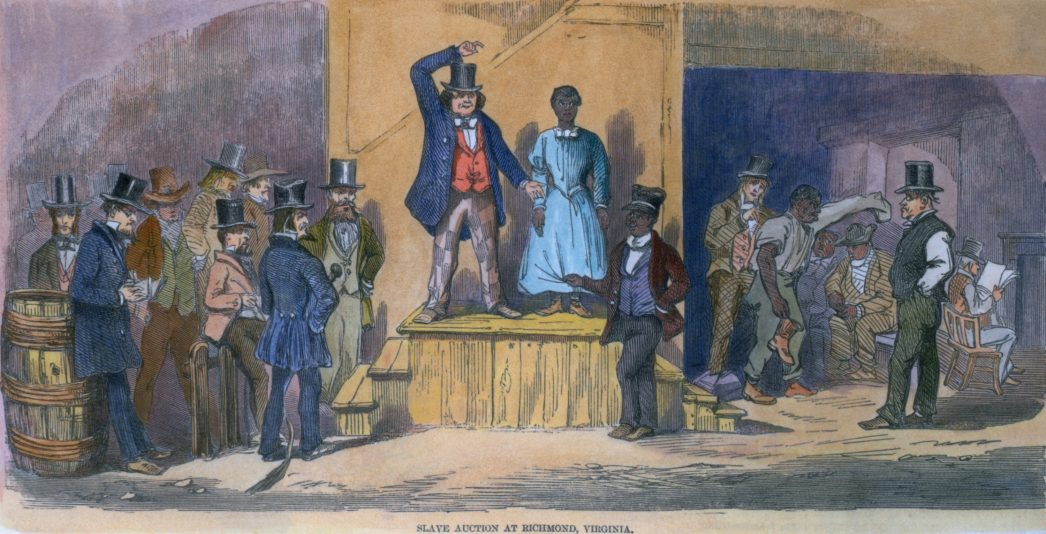By 1822, pro-slavery American Conservatives had for decades portrayed themselves as Christian gentlemen, as reasonable men, who, if anything, were doing their enslaved African property a favor by keeping them as slaves. For they sincerely believed that Africans were inherently inferior to themselves, had never contributed anything towards the advancement of humankind, and whose feeble minds and docile, even subservient demeanors made them ideal for a life of servitude.
They assured those in the North who were still undecided of the inherent evils of slavery that enslaved Africans enjoyed being their slaves. They argued that slaves were not treated poorly, that slaves were really like children and although a child does need rearing, such punishments were used sparingly and when and if violence was used excessively it was always justified by the circumstances.
But while slave owners publicly showed no doubts regarding the loyalty and contentment of their slaves who waited on them hand and foot, the strict laws they passed governing how and when slaves could gather and assemble spoke otherwise.
The fact was that while they were insisting to Northerners that their slaves were docile household pets that just happened to wash floors, prepare meals, look after their children and do the extensive labor that was making them some of the wealthiest men on earth, they also believed that under certain circumstances, they were also capable of showing a very real savage and violent side.
Often what one man calls a terrorist another man calls a hero.
The same was true for the Haitian Slave Rebellion of 1803.
Pro-Slavery American Conservatives focused on any violent act perpetrated by the enslaved Africans against the French, particularly the merciless slaughter of 5,000 white Haitians, and pointed to that as evidence of the inhuman bestial like savagery the African was capable of.
News of enslaved Africans rising up and defeating Emperor Napoleon and establishing their own Republic was not seen as an act of barbaric savagery by the enslaved Africans here in America. In fact, it was quite the opposite. It showed them that maybe their dreams could be realized through violence. Let’s face it, enslaved Africans outnumbered whites everywhere in the Antebellum South. If it worked there, why not here? The pro-slavery American Conservatives were right to be concerned that news of a successful slave rebellion in Haiti might give their slaves ideas.
One such person who caught such an idea was a man named Denmark Vesey.
Vesey along with several other conspirators planned a slave uprising in South Carolina in 1822 that would’ve involved thousands across several plantations. The ultimate plan was to liberate as many enslaved Africans as they could, murder their slave owners if necessary, and then get onto ships and sail to Haiti to live in this new all-Black Republic free from oppressive Whites.
Vesey’s conspiracy however was discovered and put down without a single loss of life.
What scared the bejesus out of whites not just in South Carolina but across the entire south was that they weren’t supposed to have worried about blacks like Vesey. Vesey was born a slave but had paid for his freedom. He was a free man. He owned his own successful business. He was well off comparatively speaking for a Negro in 1822 Charleston, South Carolina. And more importantly, he was a Christian. He had helped found an African Methodist Episcopal Church in Charleston in 1818.
White slave owners were very clear on the version of Christianity that they offered to their enslaved Africans. One emphasized obedience to their masters in this life so that they could be rewarded in the next. They taught them to surrender any thoughts of freedom in this life, all of their joy and happiness awaited them in the next.
But had they looked a little closer Denmark Vesey was exactly the type of person they should’ve been concerned about. Although Vesey had his freedom and had a successful business, he was still powerless to do what he wanted most, which was to purchase the freedom of his wife.
You see, her master flat out refused to sell her to him. What is the point of having freedom, a successful business etc. if your wife can be raped and beaten and even sold away at the whim of someone else and you are completely powerless to do anything about it? And that wasn’t even the worst part. Since his wife was a slave, any children Vesey had with his wife would inherit the status of the mother. So since the mother was a slave, their children would be slaves. Again this would be insufferable for any father to know his children were the property of someone to do with as they pleased, including selling them away never to be seen again.
It was this very reason, to be reunited with his wife and children that motivated Vesey to plan a revolt.
His church was closed by authorities not once but twice on suspicion that he was teaching slaves how to read in the basement. He was also accused of, in so many words, using scripture to give slaves “hope” for their freedom.
Ah, they had no idea how right they were.
Vesey had read passages in the Bible, particularly in the Old Testament that had him convinced that it was totally permissible to murder slave owners to free enslaved Africans. He used the story of God liberating the Israelites from Egypt as the foundation of his argument that God was against slavery and that what they were planning to do was condoned by God.
At almost every meeting, it was said, Vesey or one of his comrades “read to us from the Bible, how the children of Israel were delivered out of Egypt from bondage.’ “He (Vesey) then read in the Bible where God commanded , that all should be cut off, both men, women and children, and he said, he believed, it was no sin for us to do so, for the Lord had commanded us to do it.” – Testimony of Rolla, belonging to Thomas Bennett, recorded in the Trial Record of the Denmark Vesey Slave Conspiracy of 1822.
By the time the authorities caught on to Vesey’s plan, Vesey had gathered the support of slaves both in the city of Charleston and in the surrounding areas. Literally thousands of these docile, content, “house pets” had pledged themselves to his conspiracy. Vesey had created an extensive network of supporters that even included former Haitian slaves that had been brought to America when their French masters had fled the slave rebellion in Haiti. Their plan was to raid the Charleston Meeting Street Arsenal first, arm themselves to the teeth, commandeer some ships, kill whatever whitey got in their way, hop on these boats and sail off to Haiti, lickety split.
What could go wrong?
Actually, his success in getting people to join his cause was his downfall. Simply too many people knew of his plan. Two mulatto house slaves, George Wilson and Joe LaRoche, both deeply loyal to their masters, spilled the beans of the conspiracy to the authorities and it was a wrap. The whole plan ended before it even began.
In the end some 67 men were convicted of conspiracy and they hanged 35, including Vesey, in July 1822.
When the newspapers in the North got word of the extent that Vesey had managed to build a network of people willing to carry out these plans it placed a noticeable black eye to the image of the enslaved African as a content, docile house pet.
They had escaped fate in Charleston. Haiti didn’t have many George Wilsons or Joe LaRoches to tip them off.
But the most chilling slave revolt in American history, bar none, was yet to come.
And they would get much further along than Vesey because this time they planned for George Wilsons and Joe LaRoches.
And America wouldn’t have long to wait.

